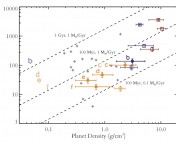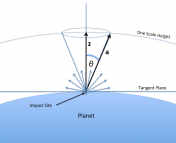- Paper Title: On the Orbits of Low-Mass Companions to White Dwarfs and the Fates of the Known Exoplanets
- Authors: Nordhaus and Spiegel
- First Author’s Affiliation: Rochester Institute of Technology, Rochester, NY, USA
- Journal: Monthly Notices of the Royal Astronomical Society (Accepted)
Overview
One of the more exotic discoveries of the exoplanet era has been the discovery of planets orbiting stellar remnants. The very first planets discovered were actually found orbiting pulsars. Substellar objects (objects much less massive than stars but not quite planets) have been found orbiting white dwarfs. White dwarfs are the remnants of Sunlike stars, while pulsars are the remnants of more massive stars.
In recent years, scientists have proposed looking for planets around white dwarfs. Such planets would be appealing targets because they are not too much smaller than white dwarfs; an Earth transiting a white dwarf would block out about half its light, a really big change, meaning such planets would be easy to find and characterize. Compare that to an Earth orbiting a Sunlike star, where the change in brightness is only about 85 parts per million!
A planet orbiting a white dwarf would have to go through a lot! White dwarfs evolve from stars like our sun. Near the end of its lifetime, a Sunlike star evolves into a red giant, growing orders of magnitude in size and engulfing close-in planets. Even if the planets escape engulfment they have to deal with the matter streaming off the star in the star, as it sheds its outer layers and evolves from a red giant into a very small, very hot white dwarf.
This paper presents a theoretical, semi-analytic study of the orbital evolution of such planets, if they exist. Specifically, the paper asks three key questions:
1. How far out does a planet need to orbit (how large does its semimajor axis, a, need to be) to escape engulfment, and what happens to its orbit as the star evolves?
2. What happens to a planet that survives engulfment? Under what conditions might it survive?
3. Suppose an Earth or super-Earth is detected in the habitable zone of a white dwarf. What are the chances that it is actually habitable instead of a burnt-out cinder?
Method
The authors start by asking what causes the semimajor axis of the planet’s orbit to change as the star evolves, first into a red giant and then into a white dwarf. They identify two effects. First, there is the effect of mass loss from the star. As the star sheds its outer layers in the red giant phase, its mass decreases. This effect causes a (the semimajor axis) to increase. Second, there is the effect of tidal forces. Broadly speaking, tidal interactions over time tend to circularize the planet’s orbit and synchronize the system’s rotations, such that the star and planet present the same face to each other. This process deposits energy in the envelope (outer layers) of the star. More often than not, this loss of orbital energy tends to cause a to decrease.
Tidal effects drop off far more strongly with increasing semimajor axis than the mass loss effect. This means that if a planet is far enough out to escape engulfment, it will experience very few little tidal effects, and will tend to outspiral (a will increase). By contrast, if planets are close enough in to be engulfed, the effects of tidal interactions will be strong, and the planets will tend to inspiral (a will decrease). Figure 1 summarizes this effect.

Figure 1: schematic indicating divergent fates of planets orbiting stars that will evolve into white dwarfs. Planets that are far away enough to avoid engulfment will experience outspiraling and end up far away from the star (blue planet in figure). Planets that are close enough to be engulf will inspiral and end up close to the star (red planet in figure). Planets that were close together initially will end up far apart if they are on different sides of the engulfment distance. This creates a period “gap” of forbidden periods where no planets should be found.
Results: Hot Jupiters
Figure 2 presents a contour plot showing the escape distance to escape engulfment for different planet and star masses. Note very massive objects can be quite close to their star and avoid engulfment; this is because they impose much stronger tidal forces on the star, allowing them to synchronize rotations quickly and end tidal effects early.

Figure 2: escape distances for stars and planets of different masses. The green curves are lines of equal escape distance. The color code gives the escape distance in AU. Escape distances are smallest for large planets and small stars.
For an engulfed planet to survive, it must 1) avoid being ripped to pieces by tidal forces, and 2) be able to eject enough tidal energy into the envelope of the star to unbind (blow away) the engulfing envelope. This is a tricky calculation and very model dependent. Figure 3 summarizes the minimum survivable distance for two different assumed model parameters; only very massive objects can survive.

Figure 3: the minimum survivable distance (here parametrized by period) for planets orbiting stars of different masses. The blue regions are where a planet would definitely be destroyed, either by the stellar envelope or by tidal forces. The two orange dot-dash lines represent minimum survivable contours for two different values of a particular model parameter alpha. The diamonds and circles shown represent known companions to white dwarfs.
Figure 4 summarizes the fates of the known exoplanets. None of the planets that are engulfed will survive. It doesn’t look good for planets fated for engulfment (including our own Earth!)

Figure 4: the eventual fates of the known exoplanets. The red planets will be engulfed by the red giant and be destroyed. The blue planets represent the initial positions of the surviving, non-engulfed planets. These planets will move outwards in their orbits due to mass-loss; their final positions are in green. The yellow star represents Jupiter for scale.
Results: Habitable Earths?
What if we discover an Earth-sized planet in the habitable zone of a white dwarf (a planet that receives just enough light for water to be liquid on its surface)? Could it possibly be habitable?
There are two ways for such a planet to get there. First, it might have been engulfed by the star and inspiraled. However, on its way to the habitable zone the planet would have been exposed to temperatures of as much as a million Kelvin, charring it to a cinder if not destroying it. Additionally, the inspiral would have to be very finely tuned to let the planet spiral in to just the habitable zone but no further. It’s much more likely that the planet would have spiraled entirely into the star.
Second, the planet might have escaped engulfment and been scattered closer to the white dwarf due to interactions with a massive companion. This scattering would give the planet a very high-eccentricity (very elliptical) orbit such that it would reach quite close to the star, and then tidal friction could damp it into a circular, habitable-zone orbit. However in this case, a lot of orbital energy would have to be dissipated in the tidal fricative process. Temperatures on the planet would be on the order of thousands of Kelvin. Again, only a charred cinder would be left. Earth-sized planets in the habitable zones of white dwarfs are unlikely to be habitable.
The picture does not look good for Earth-sized planets orbiting white dwarfs. Left to Nature, when our own Sun becomes a red giant, our own planet is doomed to extinction. Perhaps, though, there is hope. Perhaps our descendants, billions of years hence, will feel a nostalgic attachment to the mother planet. Infinitely more advanced than ourselves, they may choose to slingshot asteroids past the Earth, each flyby increasing the Earth’s orbital energy and nudging its orbit out a little farther until at last we sit at 1.5 AU: safely beyond engulfment, illuminated by the red light of a dying star. Or perhaps they will deem that too aesthetically displeasing, and set the planet wandering beyond our solar system, to find another yellow G-dwarf to call home.
I personally hope they do. I quite like the Earth. And a change of scenery is never a bad idea :).
Caveats
The authors adopted a number of simplifying assumptions. These included circular orbits, and constant mass and moment of inertia for the planet. Assumptions like these are often made to make calculations like these tractable, but they are an important caveat to keep in mind when considering the results from these papers.





Loved this! Couldn’t a “burnt” earth-like planet be “restarted” once it is stably orbiting the white dwarf? I mean, for instance, if comets deliver much water to it and fill some oceans (our Earth’s water could be brought by comets early in Solar System’s history). I’m excited because with a white dwarf, the planet would have literally trillions of years to find a way of hosting life sustained by the star. Obviously the time factor is important for life, but when you’re around a white dwarf, knowing of it’s lifespan and it’s stability, even the improbable event of having oceans being filled up by water coming from comets late in the planetary system’s evolutionary phase becomes, it seems to me, not so implausible.